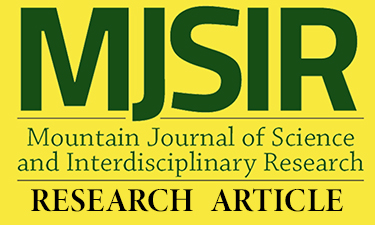Makibaa The Living Out Experiences among the Imiligan of Upper Bauko, Mountain Province
Main Article Content
Abstract
This study was conducted to document the living out (makibaa) practice in Bauko, Mountain Province. While migration generally happens purposely for economic and political reasons, the youth from this indigenous people’s village migrated because of their desire for educational advancement albeit the temporary period.
The study was about the iMiligan youth leaving their biological families to live with non-relatives in the lowlands. The research included the problems that the baa (foster children) encountered and how they managed such problems. Using descriptive method and purposive sampling technique, responses were gathered through in-depth interviews involving 26 key informants. Findings revealed that the participants moved to various destinations in the lowlands due to push and pull factors. The push factors are economic, geographical, social, political, and education. The pull factors are availability and proximity of schools, educational opportunities, values and skills’ development, and high demand from the among (foster parents). Participants described their stay in the lowlands as memorable, rewarding, and gratifying although some encountered negative experiences. Participants employed varied strategies in response to the negative encounters. The choice of destinations and prospective foster families followed some schemes and strategies such as referrals from former or current baa; by invitation from prospective foster parents or referrals of foster parents; and through request of biological parents for foster families.
Article Details
References
Australia 2007-08. Canberra, ACT: AIHW.
Battistella, G. & Conaco, MC. G. (1996). “Impact of
Migration on the Children Left Behind” in the Asian
Migrant, Volume 9 Issue No. 3.
Blau, P. M. (1964). Exchange and Power in Social Life.
New York: Wiley.
Chipungu, S. & Bent-Goodley, T. (2004). Meeting
the Challenges of Contemporary Foster Care.
Journal Issue: Children, Families, and Foster Care
Volume 14 Number 1 Winter.
Crabtree, V. M. & Witcher, L. A. (2008). Impact of
Sleep Loss on Children and Adolescents. Retrieved
from https://pdfs.semanticscholar.org/4ac2/
778ff130e9b088c553aaa38f2dfb6c2fd9bc.pdf.
Cropanzano, R. & Mitchell, M. S. (2005). Social
Exchange Theory: An Interdisciplinary Review.
Journal of Management. Vol. 31 No. 6.
Dahl, R. E. (1999). The Consequences of Insufficient
Sleep for Adolescents: Links Between Sleep and
Emotional Regulation. Phi Delta Kappan 80(5):354-
359
Dumaraog, K., Eva, J. E. M., Galvez, L., Garcia, AL.,
Lanuza, EA., Malit, R., & Marigmen, M. (2012).
Push and Pull Factors Affecting Migration from
Bicol Region to Metro Manila. Retrieved August 30,
2014 from www.academia.edu.
Emerson, R. M. (1981). Social Exchange. Social
Psychology: Sociological Perspective. New York, NY:
Basic Books.
Gaultney, J.F. (2010). The Prevalence of Sleep Disorders
in College Students: Impact on Academic
Performance. Journal of American College Health,
59:2. pp 91-97. Retrieved May 3, 2018 from DOI:1
0.1080/07448481.2010.483708.
Gouldner, A. W. (1960). The Norm of Reciprocity:
Apreliminary statement. American Sociological
Review.
Greenberg, M. S. & Frisch, D. M. (1972). Effect of
Intentionality on Willingness to Reciprocate a
Favor. Journal of Experimental Social Personality.
Grohol, J. M. (2013). 15 Common Defenses. Psych
Central. Retrieved from http:/psychcentral.com.
Homans, C. G. (1961). Social Behavior; Its Elementary
Forms. New York: Harcourt, Brace & World.
Leary, M. (2011). Self, Identity, and Reactions to Distal
Threats: The Case of Environmental Behavior.
Psychological Studies Journal, 56(1). pp 159-166.
Lee, E. (1966). A Theory of Migration. Demography,
3(1). pp. 47-57. Population Association of America.
LeMoyne, R. (2005). Childhood under Threat: The
State of the World’s Children. Tens of millions of
children living in poverty in the world’s richest
countries. Retrieved on May 12, 2016 from http://
www.unicef.org/media/media_62521.html
Lin, I. M. (2004). The Content of Indebtedness and Its
Affecting Factors. National Chengchi University.
Mahon, M. F. (1998). Parents and Teachers in Education:
Can Social Exchange Theory Explain the Nature of
the Relationship? National Library of Canada.pdf
Massey, D. S., Arago, J., Hugo, G. Kouaouci, A.,
Pellegrino A., & Edward Taylor J. (1998).
Worlds in motion. Understanding international
migration at the end of the millennium. Oxford;
New York : Clarendon Press.
NSO Census. (2010). Retrieved on August 20, 2015 from
w w w . d i g p l a n e t . c o m / w i k i /
Bauko_Mountain_Province.
Parreñas, R. S. (2006). Children of Global Migration:
Transnational Families and Gendered Woes. Manila:
Ateneo de Manila University Press.
Plameras, O. (1977). Social, Economic and
Demographic Factors Related to Inter-regional
Migration Streams in the Philippines: 1960-1970.
Manila: National Census and Statistics Office.
Pruitt, D. G. (1968). Reciprocity and Credit Building in
a Laboratory Dyad. Journal of Personality and
Social Psychology.
Reyes, M. (2008). Migration and Filipino Children
Left-Behind: A Literature Review. Miriam College–
Women and Gender Institute (WAGI) for the United
Nations Children’s Fund (UNICEF). Retrieved from
http://pdf.thepdfportal.net.
Ricouer, P. (1992). Oneself as Another. Chicago, USA:
Chicago University Press.
Schofield, G. & Beek, M. (2005). Risk and Resilience
in Long-Term Foster-Care. British Journal of Social
Work. Oxford University Press.
Stanojoska, A. & Blagojce, B. (2012). Theory of Push
and Pull Factors: A New Way of Explaining the
Old, Skopje, Republic of Macedonia. Retrieved on
October 6, 2015 from http://www.academia.edu.
Thengal, N. (2013). Social and Economic Consequences
of Illiteracy. International Journal of Behavioral
Social and Movement Sciences. Vol. 2.
Weir, K. (2012). The Pain of Social Rejection. Vol. 43,
No. 4 American Psychological Association (APA).
Accessed Aug. 30, 2014.
Williams, K. D. (2012). Ostracisms: The Impact of
Being Rendered Meaningless. APA Press.
Zanker, J. H. (2008). Why do people migrate? A review
of the theoretical literature. Maastricht Graduate
School of Governance.
Zentgraf, K. M. & Chinchillaa, N. S. (2012).
Transnational Family Separation: A Framework for
Analysis. Journal of Ethnic and Migration Studies,
Volume 38, Issue 2, 2012.

